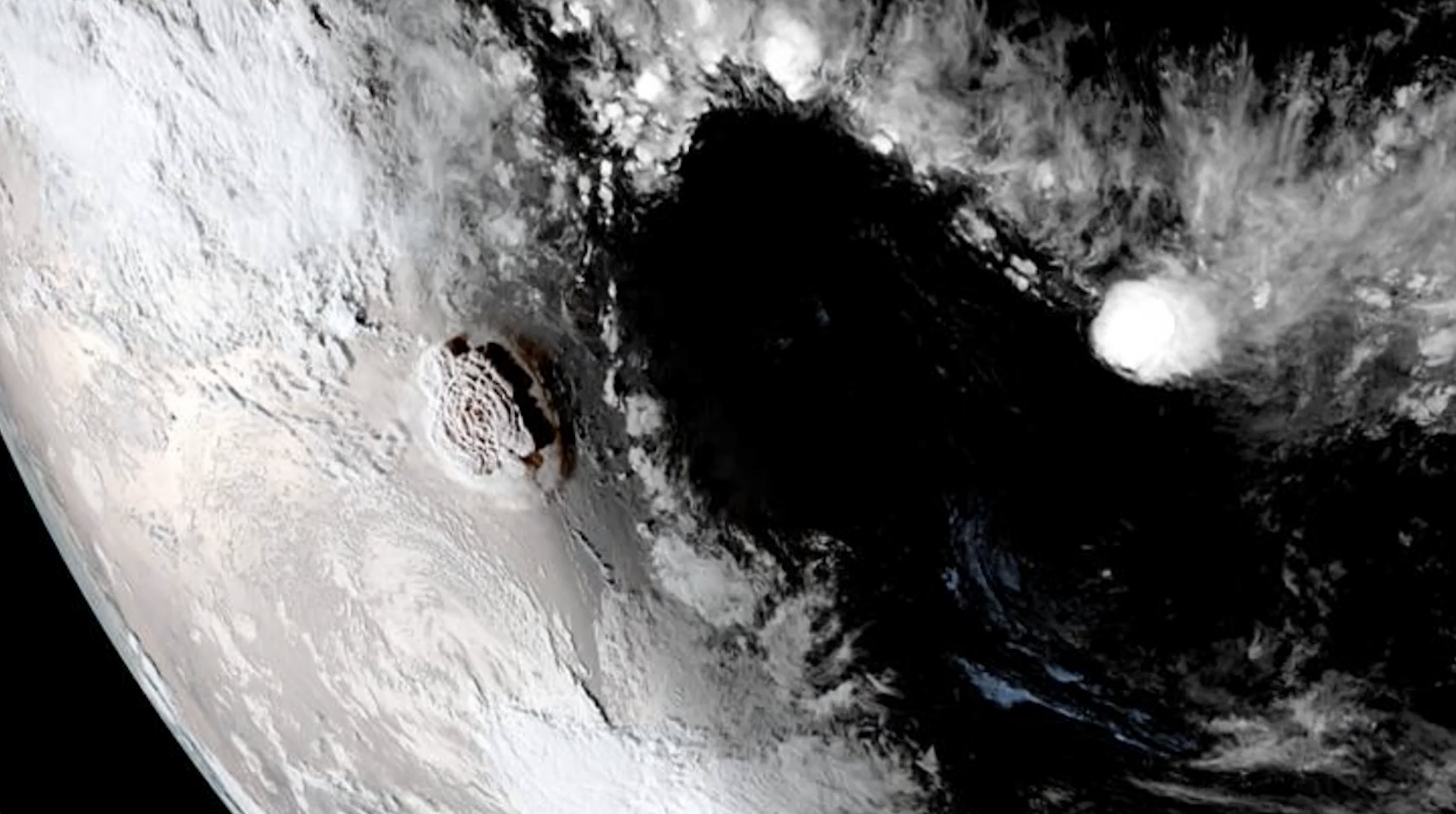Huge Tonga underwater volcano eruption captured in stunning satellite video
The new eruption on Jan. 15 spawned a 4-foot tsunami and sent an ash cloud 12 miles high.
A powerful underwater volcano eruption in Tonga on Saturday (Jan. 15) was captured as it happened in stunning images from an Earth-watching satellite, showing the sheer power for the explosive event in the South Pacific.
The volcano eruption on the island of Hunga Tonga-Hunga Ha'apai is visible as a spectacular explosion in views from the GOES West Earth-observing satellite operated by the U.S. National Oceanic and Atmospheric Administration (NOAA). A video of the eruption shows a vast plume from the volcano rising high into the atmosphere like a giant mushroom during the eruption as a shockwave extends outward from Hunga Tonga-Hunga Ha'apai, one of the 170 islands that make up the South Pacific kingdom of Tonga.
Related: 10 incredible volcanoes in our solar system

This is the #volcano eruption near #Tonga that has prompted a #Tsunami Advisory for the U.S. West Coast and #Hawaii. It occurred at 0410 UTC today, 1/15/22, and could be heard across the South Pacific and as far away as Alaska. https://t.co/veNxgO2NuY pic.twitter.com/8mfX0AouUFJanuary 15, 2022
The eruption spawned a 4-foot tsunami that hit Tonga's capital of Nuku’alofa, which is about 40 miles (65 kilometers) south of the volcano. A sonic boom from the eruption was heard across the Pacific Ocean, reaching as far away as Alaska, according to the Associated Press.
Nuku’alofa was reportedly covered in a thick film of volcanic dust, according the AP. There have been no official reports of injuries or damage from Tonga's capital, but its internet access was interrupted by the event, the AP added.
The volcano on Hunga Tonga-Hunga Ha'apai first erupted on Dec. 20 and then exploded with a massive eruption on Jan. 13, which was also spotted by GOES West, NOAA officials said in a statement. That eruption was seven times more powerful than the December event and sent a huge plume of ash and gas over 12 miles (20 kilometers) into Earth's atmosphere.
Saturday's eruption also sent an ash plume to an altitude of nearly 12 miles, New Zealand Prime Minister Jacinda Ardern told the AP. New Zealand officials hope to send military surveillance flights over the volcano on Monday to assess its status, followed by aid and supplies for Tonga, where water supplies may be contaminated, Ardern added.
Get the Space.com Newsletter
Breaking space news, the latest updates on rocket launches, skywatching events and more!
Email Tariq Malik at tmalik@space.com or follow him @tariqjmalik. Follow us @Spacedotcom, Facebook and Instagram.
Join our Space Forums to keep talking space on the latest missions, night sky and more! And if you have a news tip, correction or comment, let us know at: community@space.com.

Tariq is the Editor-in-Chief of Space.com and joined the team in 2001, first as an intern and staff writer, and later as an editor. He covers human spaceflight, exploration and space science, as well as skywatching and entertainment. He became Space.com's Managing Editor in 2009 and Editor-in-Chief in 2019. Before joining Space.com, Tariq was a staff reporter for The Los Angeles Times covering education and city beats in La Habra, Fullerton and Huntington Beach. In October 2022, Tariq received the Harry Kolcum Award for excellence in space reporting from the National Space Club Florida Committee. He is also an Eagle Scout (yes, he has the Space Exploration merit badge) and went to Space Camp four times as a kid and a fifth time as an adult. He has journalism degrees from the University of Southern California and New York University. You can find Tariq at Space.com and as the co-host to the This Week In Space podcast with space historian Rod Pyle on the TWiT network. To see his latest project, you can follow Tariq on Twitter @tariqjmalik.









